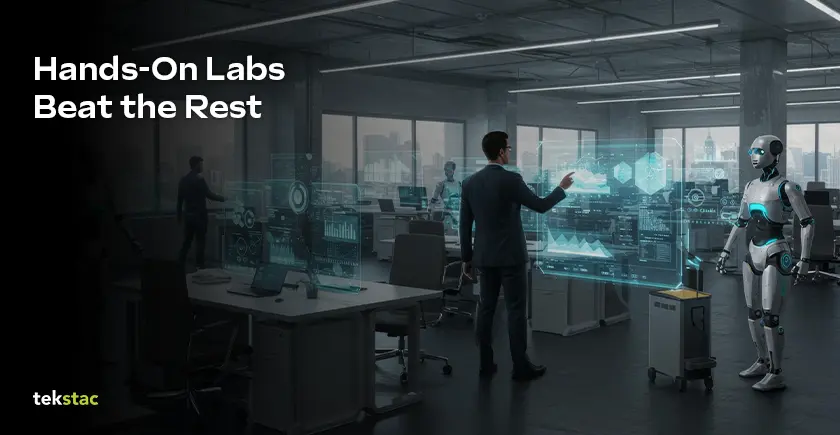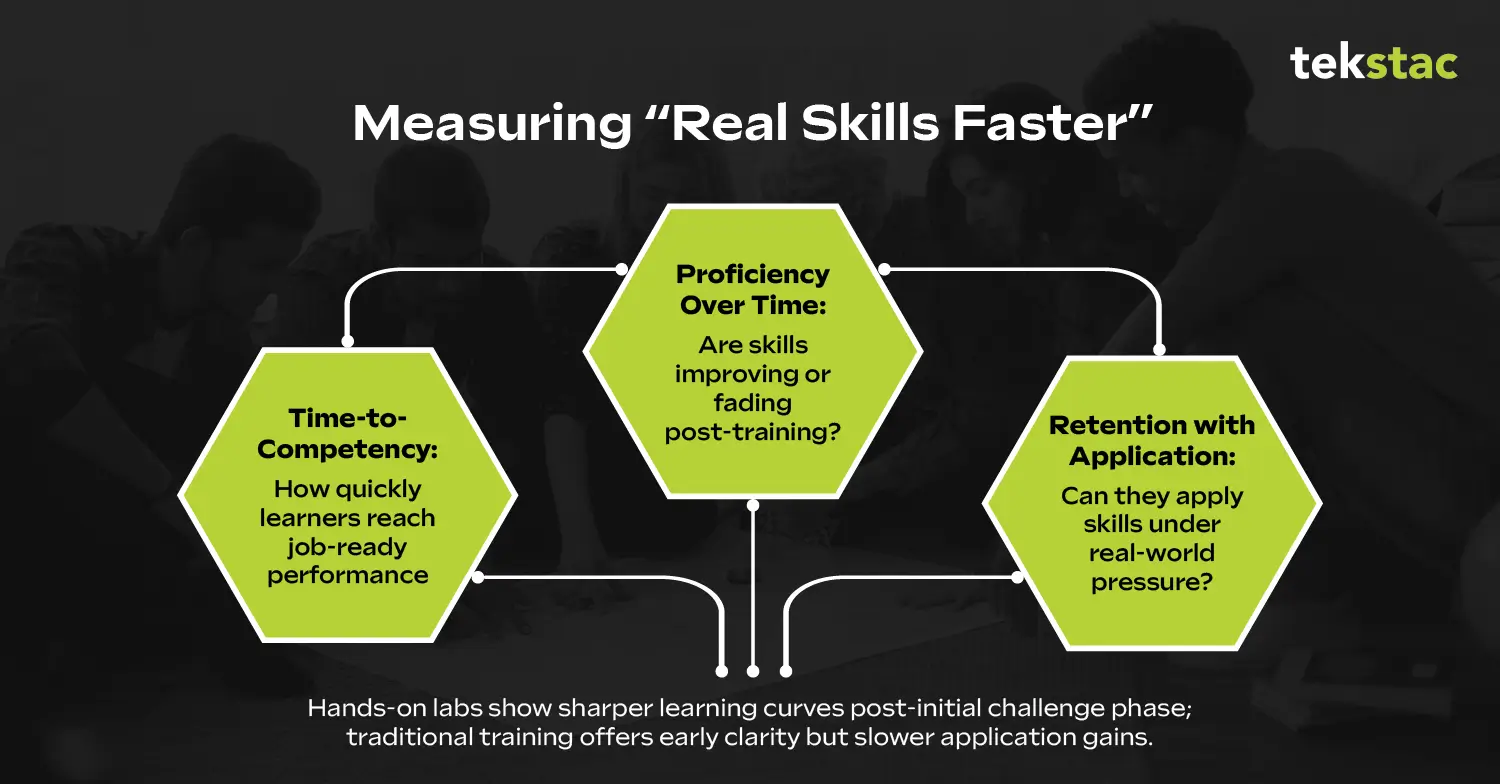Hands-On Labs vs Traditional Training: Which Builds Real Skills Faster?
August 11, 2025

The learning and development world often finds itself at a crossroads — Hands-On Labs vs Traditional Training.
Organizations pour resources into training programs in efforts to see their teams learn new skills quickly and effectively. A lot of traditional training just doesn’t stick. People often get the theory but struggle when it’s time to actually do the job. That gap slows things down, drains money, and holds teams back.
So what works better? Should you go for hands-on labs where people learn by doing? Or stick with classroom sessions and online courses? The answer can change everything from budget allocation to employee confidence in their skills.
What Are Hands‑On Labs vs. Traditional Training?
Hands-on labs allow employees to practice skills in a simulated or real world environment. Picture this—someone in cybersecurity working through real network attacks in a safe virtual setup. Or a med student practicing on high-tech simulation gear before ever touching a real patient. These labs might be physical, fully online, or a mix of both.
Now compare that to traditional training. It’s more about lectures, slides, and guided lessons. Everything’s laid out in a set format, usually in a classroom or through online courses. This approach prioritizes understanding concepts before moving to application.
How Do We Measure “Real Skills Faster”?
To measure real skills faster, we look at metrics such as:
- Time-to-competency
- Proficiency over time
- Retention with application
Measuring speed in skill development requires looking at how fast learners reach actual job competency, i.e., the point where they can perform tasks independently without constant guidance or review.

1. Time-to-competency: This tracks the period from initial exposure to independent performance. This metric matters especially in hands-on labs training method because it shows real business impact. Some learners might finish traditional courses quickly but can still struggle when faced with actual work situations.
2. Proficiency over time: This metric checks how skills evolve after initial training, whether learners are continuing to improve. More importantly, it helps understand if employees retained and built on what they learned, or if skills deteriorated without reinforcement.
3. Retention with application: This metric helps measure if skills are translating successfully into real-world scenarios. It assesses whether learners can successfully apply learned skills weeks or months later when the pressure is on. It’s one of the core metrics of training methods such as hands-on labs or immersive labs.
Studies show hands-on training and traditional learning don’t follow the same curve. People in labs might hit a rough patch early on. It feels harder at first. But once they get it, things move fast.
On the other hand, traditional training methods typically produce smoother, more predictable curves early on. Learners build knowledge, and assessment results look more consistent in the short term. However, the real test comes during transition to actual application, where learners face a secondary learning curve as they adapt to practical situations.
Evidence: Which One Builds Skills Faster?
Below, let’s examine in detail which training method helps build and apply skills faster, whether it’s hands-on labs, traditional training, or both.
1) Hands-On Labs: Strengths and Limitations
Hands-on labs can require higher investment amounts due to purchase of equipment, software, and specialized instruction. But they may reduce the time employees spend transitioning from training to productive work.
Hands-on training creates conditions that naturally accelerate skill development. When learners face challenges in simulated environments, they must solve them immediately. This can create a pressure-cooker effect where learning happens under conditions that mirror real business situations.
Hence, the feedback loop in hands-on environments operates at a higher speed. Quick feedback makes a big difference. People catch mistakes early and learn what works by actually doing it. In hands-on setups, they’re more likely to try stuff, mess up, and figure things out. That kind of trial-and-error helps build real problem-solving skills, not just for the task at hand, but for situations they haven’t even seen yet. More than anything, it gives them the confidence to handle the unknown.
2) Traditional Training: Strengths and Limitations
Traditional training is best at building systematic understanding efficiently. Difficult topics can be broken down logically, with each concept building on previous ones. This helps develop comprehensive mental models before employees start practicing application.
Traditional training usually moves slow and steady, unlike hands-on labs. The instructor can stop and explain things before jumping ahead. That helps people who might need more time. With hands-on stuff, it’s easy to feel lost early on, especially when things get too complex too fast.
However, in contrast to hands-on labs, traditional approaches struggle with the transfer problem. Knowledge gained does not always translate smoothly to real-world application. Learners may understand concepts but hesitate when faced with actual decisions or problem-solving situations.
This nature can create artificial delays, where learners might be ready to tackle practical applications before the curriculum allows them to, leading to frustration and missed opportunities for reinforcement through practice.
3) Hybrid or Blended Approaches
Smart organizations increasingly recognize that the hands-on labs versus traditional debate does not always create the right choice for every organization. For some companies, the most effective training approach can be a combination of both, using each method’s strengths to address the other’s limitations.
Sometimes training mixes both. First, you learn the basics in a class. Then you do hands-on work to practice. Or you try things out first, ask questions, and then get the lessons to make sense of it all.
Here, the key is in timing and integration. Rather than treating these as separate phases, effective blended approaches integrate theory and practice together, allowing learners to move fluidly between understanding concepts and applying them in realistic contexts.
With technology, organizations can perfectly balance theoretical resources while working through practical challenges, or where simulation environments include embedded coaching and explanatory content that appears when needed.
The best training blends both worlds.
Give your team the skills they need now—and the growth path for tomorrow.
See How Tekstac Helps.
Variables That Affect How Fast Employees Learn
Not everyone learns at the same speed. Some pick things up quickly, others take their time. That’s not a bad thing. It usually means the training style doesn’t fit their experience, situation, or sometimes the content itself.
1. Learner Experience Level (Novice vs Advanced)
Experience level dramatically influences which training approach will build skills faster. When you’re new, it helps to learn step by step. Jumping into hands-on work right away can be tough if you don’t know the basics.
That said, beginners can still learn well with hands-on tasks—as long as they’re not too hard. The goal is to build confidence, not show what you don’t know.
If you already have some experience, hands-on usually works best. You can connect new stuff to what you already know and learn faster. They can fill in knowledge gaps independently as they encounter them during practice.
Experienced professionals can find traditional training frustrating because it moves too slowly through concepts they already understand partially. They prefer to jump into application and learn through problem-solving, using theoretical resources as needed to support their practice.
2. Training Context: High-Risk vs Low-Risk Environment
The stakes involved in skill application influence training design. In high-risk places, where mistakes can cause big problems, it’s better to start with careful traditional training before trying hands-on work. In low-risk settings, people can experiment more and learn by making mistakes without causing trouble.
Hence, the risk level also affects the design of hands-on training itself. High-risk skills require carefully controlled simulation environments that can replicate realistic conditions without actual danger, while low-risk skills might be practiced in real situations with minimal modifications.
3. Context Difficulty (Simple Procedural vs Conceptual Strategy)
Simple tasks work well with hands-on learning. When learners can see the results right away—like using software, handling equipment, or following a set process—they pick it up faster.
Skills that need big-picture thinking, analysis, or creativity often do better with traditional training first. Things like understanding markets, reading organizational behavior, or planning strategy need solid mental models that hands-on labs work alone might not build.
After people learn the basics, doing hands-on work helps a lot. Case studies, simulations, or real projects let them try out what they know and get better in ways lectures don’t. Usually, it works best to break skills into steps—first teach the ideas, then practice in hands-on labs, and finally mix both with real experience.
The Path Forward
After understanding both approaches, the evidence points to a clear conclusion that the hands-on labs versus traditional training misses the real opportunity to integrate them intelligently through technology platforms that combine the systematic knowledge-building of traditional training with the immediate application benefits of hands-on labs.
The most effective approach integrates structured learning content with immersive practice environments. These are backed by real-time assessment and personalized guidance. When learners can access resources when they need them while working through realistic scenarios, they develop both understanding and performance.
Modern learning platforms like Tekstac exemplify this integrated approach. They combine extensive sandbox environments for real-world practice. Learners can move fluidly between both as their needs and progress dictate. Tekstac’s intelligent assessment and analytics track actual skill development patterns. Its AI-powered proctoring and plagiarism detection help ensure credibility, while predictive analytics identify skill gaps.
While speed matters, sustainable speed matters more. Hence, integrated learning platforms deliver both immediate impact and long-term capability, creating learning experiences that truly improve performance.





